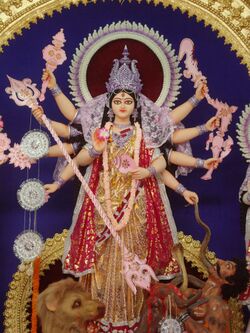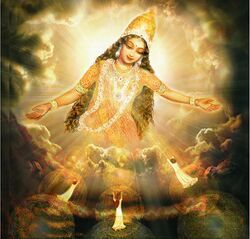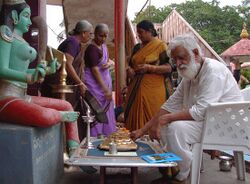Philosophy:Shakti
| Shakti | |
|---|---|
 Durga, a goddess regarded to be a popular form of Shakti | |
| Affiliation | Adi Parashakti, Devi, Durga, Mahalakshmi, Parvati, Saraswati |
Shakti (Devanagari: शक्ति, IAST: Śakti; lit. "Energy, ability, strength, effort, power, capability"[1]) is the fundamental cosmic energy and a central deity within Shaktism, a significant theological tradition of Hinduism. Representing dynamic forces that permeate the universe,[2] Shakti embodies feminine energy and is often depicted as the consort of Shiva.[3] In this tradition, Devi, the Goddess, is regarded as the Supreme Brahman herself, with all other divine forms seen as her manifestations. The worship of Shakti entails a diverse array of goddesses, including Durga, Kali, Parvati, and Tripura Sundari, each representing unique facets of her power.
One of the central concepts is Adi Parashakti, the supreme goddess who underlies all other goddesses and can be linked to different deities like Lakshmi, Parvati, and Durga in various Hindu traditions. Shaktism's historical roots trace back to ancient times, with early artifacts like the Baghor stone indicating the presence of goddess worship in India during the Paleolithic era. The Smarta Advaita sect, within which Shaktism is a key element, acknowledges Shakti as one of five equal forms of God, promoting domestic worship and unity amidst diverse Hindu philosophies. Shaktism's synthesis with regional traditions is evident in South India, where goddesses like Amman embody her presence and are celebrated as protectors and providers in local communities.
Origins
Shakti, the goddess, was found in a Paleolithic context in the Son River valley. It is a triangular stone known as the Baghor stone and is estimated to have been created around to 9,000–8,000 BCE.[4] The representation of Shakti in a stone is considered an early example of a yantra.[5] Kenoyer, part of the team that excavated the stone, considered that it was highly probable that the stone was associated with Shakti.[6]
Shaktism
Shaktism regards Devi (lit., "the Goddess") as the Supreme Brahman itself with all other forms of divinity considered to be merely Her diverse manifestations. In the details of its philosophy and practice, Shaktism resembles Shaivism. However, Shaktas (Sanskrit: शक्त, Script error: The function "transl" does not exist., ), practitioners of Shaktism, focus most or all worship on Shakti, as the dynamic feminine aspect of the Supreme Divine.[7]
From Devi-Mahatmya:
By you this universe is borne,
By you this world is created,
Oh Devi, by you it is protected.[8]
From Shaktisangama Tantra:
Woman is the creator of the universe,
the universe is her form;
woman is the foundation of the world,
she is the true form of the body.
In woman is the form of all things,
of all that lives and moves in the world.
There is no jewel rarer than woman,
no condition superior to that of a woman.[9]
Adi Parashakti
Mahadevi (Sanskrit: महादेवी, IAST: Mahādevī), also referred to as Adi Parashakti, Adi Shakti, and Abhaya Shakti, is the supreme goddess in the Shaktism sect of Hinduism. According to this tradition, all Hindu goddesses are considered to be manifestations of this single great Goddess, who is comparable to the deities Vishnu and Shiva as Para Brahman. Vaishnavas consider her to be Lakshmi, Shaivas consider her to be Parvati, Durga, Lalita and Kali, while Shaktas consider her to be Durga, Tripura Sundari, Bhuvaneshvari, and Kali. Author Helen T. Boursier says: "In Hindu philosophy, both Lakshmi and Parvati are identified with the great goddess—Mahadevi—and the Shakti or divine power".[10]
Smarta Advaita
In the Smarta Advaita sect of Hinduism, Shakti is considered to be one of five equal personal forms of God in the panchadeva system advocated by Adi Shankara.[11] The Smarta tradition (Sanskrit: स्मार्त), also called Smartism, is a movement in Hinduism that developed and expanded with the Puranas genre of literature. It reflects a synthesis of four philosophical strands, namely Mimamsa, Advaita, Yoga, and theism. The Smarta tradition rejects theistic sectarianism, and is notable for the domestic worship of five shrines with five deities, all treated as equal – Ganesha, Shiva, Shakti, Vishnu and Surya. The Smarta tradition contrasted with the older Shrauta tradition, which was based on elaborate rituals and rites. There has been a considerable overlap in the ideas and practices of the Smarta tradition with other significant historic movements within Hinduism, namely Shaivism, Brahmanism, Vaishnavism, and Shaktism.[12][13][14]
See also
- Religion:Ammavaru – Hindu goddess
- Philosophy:Iccha-shakti – Sanskrit term for willpower
- Philosophy:Kundalini – Form of divine energy in Hindu mysticism
- Religion:Mohini – Hindu goddess of enchantment, the only female avatar of Vishnu
- Philosophy:Prakṛti – Nature in Hinduism
- Philosophy:Purusha – Concept in Hindu philosophy
- Philosophy:Tridevi – Trinity of chief goddesses in Hinduism
References
- ↑ Monier-Williams, Monier. "Monier-Williams Sanskrit-English Dictionary". University of Washington. http://faculty.washington.edu/prem/mw/z.html. "śaktí f. power, ability, strength, might, effort, energy, capability"
- ↑ Datta, Reema; Lowitz, Lisa (2005). Sacred Sanskrit Words. Berkeley, CA: Stonebridge Press. p. 111.
- ↑ Rosen, Steven (2006). Essential Hinduism. Westport, CT: Praeger Publishers. pp. 166.
- ↑ Insoll, Timothy (2002). Archaeology and World Religion. Routledge. p. 36. ISBN 9781134597987. https://books.google.com/books?id=FTqCAgAAQBAJ&q=baghor%20stone%20date%20son%20valley&pg=PA36. Retrieved 3 October 2020.
- ↑ Harper, Katherine Anne; Brown, Robert L. (2012). The Roots of Tantra. SUNY Press. p. 39. ISBN 9780791488904. https://books.google.com/books?id=NtKrbKIOL5wC&q=baghor%20stone%20roots%20of%20tantra&pg=PA39. Retrieved 3 October 2020.
- ↑ Kenoyer, J.M.; Clark, J.D.; Pal, J.N.; Sharma, G.R. (1983). "An upper palaeolithic shrine in India?". Antiquity 57 (220): 93. doi:10.1017/S0003598X00055253.
- ↑ Subramuniyaswami, p. 1211[full citation needed]
- ↑ Klostermaier, Klaus K. (1989). A Survey of Hinduism. New York, NY: SUNY Press. pp. 261, 473 footnote [1].
- ↑ Bose, Mandakranta (2000). Faces of the Feminine in Ancient, Medieval, and Modern India. New York, NY: Oxford University Press. p. 115. ISBN 0195352777. OCLC 560196442.
- ↑ Boursier 2021, p. 30.
- ↑ "[no title cited"]. http://www.himalayanacademy.com/resources/books/dws/dws_mandala-02.html.
- ↑ Flood, Gavin (1996), An Introduction to Hinduism, Cambridge University Press, pp. 113, 134, 155–161, 167–168, ISBN 9780521438780.
- ↑ Sanderson, Alexis. "The Saiva Age: The Rise And Dominance Of Saivism During The Early Medieval Period". In Genesis And Development of Tantrism, Edited By Shingo Einoo. Tokyo: Institute Of Oriental Culture, University Of Tokyo, 2009. Institute Of Oriental Culture Special Series, 23, pp. 276–277.
- ↑ Shephard, John (2009), Ninian Smart On World Religions, Ashgate, p. 186, ISBN 978-0754666387
Further reading
- Datta, Reema; Lowitz, Lisa (2005). Sacred Sanskrit Words. Berkeley, CA: Stonebridge Press.
- Feuerstein, Georg (2000). The Shambhala Encyclopedia of Yoga. Boston, MA: Shambhala Publications.
- Harish, Ranjana; Harishankar, V. Bharathi (2003). Shakti: Multidisciplinary perspectives on women's empowerment in India. New Delhi, IN: Rawat. ISBN 81-7033-793-3.
- McDaniel, June (2004). Offering Flowers, Feeding Skulls: Popular goddess worship in West Bengal. Oxford University Press.
- Shaw, Miranda (1994). Passionate Enlightenment: Women in Tantric Buddhism. Princeton, New Jersey: Princeton University Press.
- Tiwari, Bri. Maya (2002). The Path of Practice: A woman's book of Ayurvedic healing. Motilal Banarsidass Press.
- Woodroffe, John (1910). Shakti and Shakta. Forgotten Books. ISBN 1-60620-145-X. https://books.google.com/books?id=3e3_GVggCgUC&q=Hinduism&pg=PA325.
- Woodroffe, John (1952). Hymns to the Goddess. Forgotten Books. ISBN 1-60620-146-8. https://books.google.com/books?id=4VUS2Rxmy_QC&q=John+Woodroffe&pg=PR7.
- Woodroffe, John (1922). Hymn to Kali: Karpuradi Stotra. Forgotten Books. ISBN 1-60620-147-6. https://books.google.com/books?id=XrAIJR37dJoC&q=John+Woodroffe&pg=PP7.
External links
Template:Hindu Deities and Texts
 |




